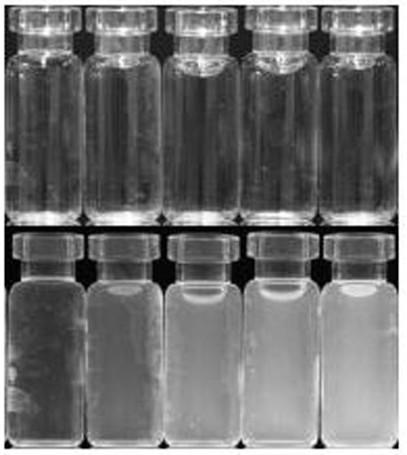Preparation method and application of a dual-ratio multifunctional high-sensitivity carboxylesterase detection fluorescent probe
A technology of functional carboxylate and fluorescent probe, applied in the field of analytical chemistry, can solve the problems of no double ratio, low detection limit of detection method, single detection method, etc., and achieve the effect of detection sensitivity
- Summary
- Abstract
- Description
- Claims
- Application Information
AI Technical Summary
Problems solved by technology
Method used
Image
Examples
Embodiment 1
[0062] Example 1: Preparation of small molecule carboxylesterase ratiometric probes
[0063] (1) Dissolve 2,4-Dihydroxybenzaldehyde (2,4-Dihydroxybenzaldehyde) in ethanol at a concentration of 0.048g / mL, then add Diethyl glutaconate at a concentration of 0.067g / mL mL, after mixing evenly, add 4 mL of anhydrous piperidine dropwise, reflux for 24 hours, cool, and a yellow solid precipitates, which is recrystallized with absolute ethanol to obtain product 1;
[0064] (2) Dissolve the product 1 in anhydrous pyridine at a concentration of 0.025g / mL, then add acetic anhydride at a concentration of 1mol / L, stir for 0.5h, add 100g of crushed ice, and stir for 10min to precipitate an off-white solid. Elute with acetonitrile-dichloromethane eluent with a volume ratio of 1:5, and spin evaporate to obtain product 2;
[0065] (3) Dissolve the product 2 in tetrahydrofuran at a concentration of 0.011 g / mL, then add 4% osmium tetroxide aqueous solution, stir for 0.5 h, then add sodium period...
Embodiment 2
[0076] Example 2: The dual-ratio multifunctional carboxylesterase detection fluorescent probe prepared in Example 1 quantitatively analyzes carboxylesterase in biological samples: detection of carboxylesterase content in serum
[0077] 1) Prepare the solution
[0078] Probe stock solution: Accurately weigh the dual-ratio multifunctional carboxylesterase detection fluorescent probe and dissolve it in anhydrous acetonitrile to prepare a probe stock solution with a concentration of 60 µM;
[0079] Carboxylesterase stock solution: Accurately weigh 0.0050g carboxylesterase of the target object to be tested and dissolve it in 1000ml distilled water to prepare a concentration of 5×10 -5 g / mL carboxylesterase stock solution;
[0080] 2) Establish a linear equation for the serum-carboxyesterase standard
[0081]Dilute the carboxylesterase stock solution prepared in step 1) with distilled water to obtain a carboxylesterase standard solution with a gradient concentration of 0-15g / mL, t...
Embodiment 3
[0087] Example 3: Qualitative detection of small molecule carboxylesterases in biological samples
[0088] The detection method of carboxylesterase in serum samples is as follows: after the serum sample to be tested is mixed with anhydrous acetonitrile at a volume ratio of 5:1, centrifuged at 5000 rpm for 20 minutes, the supernatant is taken out and processed through a dialysis membrane, and then 200 μL of dialysis is taken Add 100 μL of probe stock solution and 200 µL of carboxylesterase stock solution to the supernatant in turn, make the volume to 1000 μL with Tris-hydrochloric acid buffer solution with pH 7.46, store at 25°C for 50 min, the color is yellow-green under ultraviolet light, It can be judged that the serum sample contains carboxylesterase.
[0089] The probe stock solution and carboxylesterase stock solution in this example are the same as step 1) in Example 2. The color change of the probe with the increase of the concentration of the analyte under fluorescent...
PUM
 Login to View More
Login to View More Abstract
Description
Claims
Application Information
 Login to View More
Login to View More - R&D
- Intellectual Property
- Life Sciences
- Materials
- Tech Scout
- Unparalleled Data Quality
- Higher Quality Content
- 60% Fewer Hallucinations
Browse by: Latest US Patents, China's latest patents, Technical Efficacy Thesaurus, Application Domain, Technology Topic, Popular Technical Reports.
© 2025 PatSnap. All rights reserved.Legal|Privacy policy|Modern Slavery Act Transparency Statement|Sitemap|About US| Contact US: help@patsnap.com



